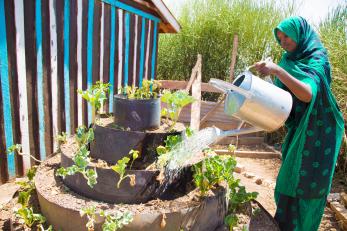Community Development and Sustainability

This progress report highlights Year 4 achievements of the USAID-funded Livestock Market Systems (LMS) Program which is being implemented in Isiolo, Wajir, Turkana, Marsabit, and Garissa Counties in Northern Kenya. The achievements are featured under the three main objectives of the program which are strengthened institutions, systems and governance, improved human capital and collaborative action and learning for community empowerment. LMS is implementing these objectives through two models namely, Ward Development Planning (WDP) and Girls Improving Resilience through Livelihoods (GIRL). Through the WDP model, LMS supported communities in forming Ward Planning Committees (WPCs) whose role is to identify community needs and develop a Ward Development Planning document which is distributed to the County Governments and development organizations to guide their development priorities.
Mercy Corps which is implementing LMS program under the objective of Strengthening Community Capacities through Resilience and Growth (SCCRG) achieved the following;
- Implementing innovation and community projects for development. In the past year, LMS through Ward Planning Committees (WPCs), actively engaged county governments during public participation in drafting the fiscal paper for initiating the annual development plans. The WPCs ensured their development priorities were included in the fiscal paper to guide technical committees during budget allocation. Across the five counties, community priorities totaling $5,585,100 have been implemented by county governments due to constant advocacy by the WPCs.
- Strengthened government and community capacity in Disaster Risk Management (DRM). The program facilitated the training of Ward Planning Committees (WPCs) on Early Warning Early Response (EWER) and linked them to the National Drought Management Authority’s systems. As a result, the WPCs have become integral in the dissemination of early warning and climate information advisories to at-risk communities using WhatsApp groups, local radio stations, and public community meetings.
- Expanded the GIRL model to other countries to reach more adolescent girls. Mercy Corps used the lessons learned in implementing the GIRL model to develop a GIRL strategy, which has been used to raise additional funds with private donors. Mercy Corps received $10 million to expand the GIRL model in Kenya, Uganda and Haiti and reach at least 70,000 adolescent girls, boys, and young women. The program will rely on the LMS AA2 GIRL model, support transition pathways among the current LMS GIRL model participants and reach an additional 10,000 adolescent girls in Kenya. LMS AA2 has also received an additional $200,000 from the Bridges Fund to support the transition pathways of at least 1,500 adolescent girls and boys in Turkana and Wajir through our local partners.
- Supported GIS Strategy planning and development. LMS supported the Wajir County Government to develop a GIS strategy based on an already existing GIS laboratory in the county. The GIS strategy was aimed at enabling the County Government to establish a County Development Management System with technology assisted levels of access including hardware-based and web-based platforms for data interaction between the executive and the public. The Wajir County Governor is fast tracking the implementation of the GIS action plan and has committed at least KES 10 million ($100,000) for implementation of the GIS action plan in the government financial year 2021/2022.To expand the vision to other countries, LMS supported a GIS learning visit for the counties of Turkana, Isiolo, Marsabit, Garissa, and Samburu. The learning visit enabled visiting counties to develop their own GIS action plan for rolling out a similar countywide data management system for decision making in their own counties.


